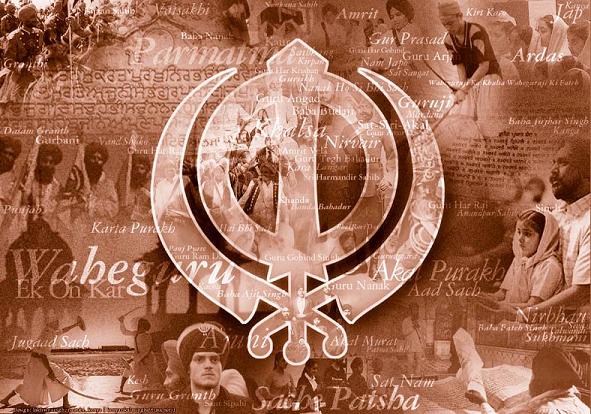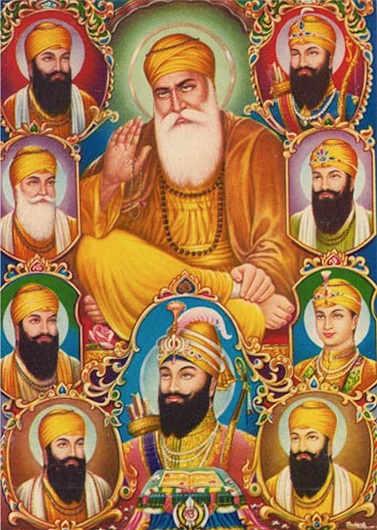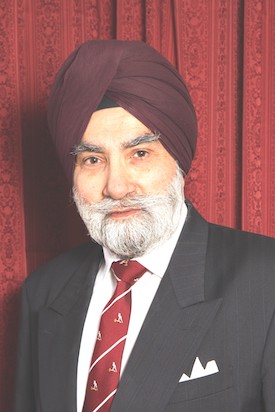Introduction
In Sikhi tradition the Guru Jote (Divine Light) was in Guru Nanak Sahib. Jugat was the way or the method for Sikhi living shown by the Guru. He laid down the foundation of Sikh ideology and institutions on the three pillars of Sikhi living: Naam Japo, Kirat Karo & Wand Shako (Constant Waheguru remembrance while living an honest and productive life, and sharing with those in need).
Thus, started the Guru tuition period of Sikhi living from 1469 to Vaiskahi 1699. As we celebrate the 550th anniversary of Guru Nanak Parkaash this year we trace the progress of the Guru Jote-Jugat from Guru Nanak Sahib to the emergence of the Khalsa in 1699. I propose to devote a few columns to this important topic leading on to Vaisakhi 2019 celebration in April. Some repetition is unavoidable and maybe even desirable.
The challenges which Sikh ideology, institutions and distinct theo-political Qaumi identity face, are many. In Sikhi, Jote is the Divine Light (the Universal Spirit) and Jugat the way. It is the guiding principle in Sikhi living or the Sikh reht (code of conduct). Jote and Jugat go together and manifest as the Miri-Piri (temporal-spiritual) twin track Sikh way of life. Sikhs are guided by the teachings enshrined in Sri Guru Granth Sahib as interpreted by the lives of the Ten Guru-persons from Guru Nanak Sahib to Guru Gobind Singh. Jote-Jugat is an unbroken continuity in Sikh tradition from Guru Nanak Sahib through the nine other Guru-persons who followed, to Sri Guru Granth Sahib.
For the above reason, Gurbani interpretation is only possible with reference to the Sikhi reht lived by the Ten Guru persons. There are attempts to separate Sri Guru Granth Sahib from the lives of Ten Guru Sahiban and the collective interpretation of Gurbani by the Guru Roop Khalsa Panth. Such attempts by ‘hijackers of Sikhi’ — an apt expression coined by Dr Karminder Singh of Malaysia – are divisive and dangerous.
Those who hold that Sikhi(sm) is a religion only that the teachings of Guru Granth Sahib are universal and that they prefer to follow the teachings of Guru Granth Sahib only, tend to deny the interpretation of Gurbani in our practical lives. That interpretation of Gurbani into lived Sikhi was done by the Guru-persons and the Guru Khalsa Panth with great sacrifices. The Sikh Reht Maryada (SRM) is the interpretation of Gurbani into a Sikh Code of Conduct and Conventions as the final outcome of Jote-Jugat twin track approach to Sikhi. Denying the Sikh Reht Maryada amounts to denial of Guru and Khalsa history (ithaas) and tradition.
The collective authority for correct interpretation of Gurbani resides in Guru Roop Khalsa Panth. That authority was bestowed on the Khalsa Panth by Guru Gobind Singh. The approach to the interpretation of Gurbani is holistic with reference to ALL the Bani in Sri Guru Granth Sahib. Otherwise, selective quotations of Gurbani to suit own thinking (manmat) lead to divisive gurudoms and deras at one extreme and self-appointed interpreters of Gurbani and Sikhi according to own biases at the other extreme.
Definition of a Sikh
ਜੋਤਿ ਓਹਾ ਜੁਗਤਿ ਸਾਇ ਸਹਿ ਕਾਇਆ ਫੇਰਿ ਪਲਟੀਐ ॥
They shared the One Light and the same way the King just changed His body.
It was stressed in the introductory that approach to the interpretation of Gurbani should be with reference to Sri Guru Granth Sahib — the Divine Light or Jote — and the Jugat or the living way (reht) as shown by the Ten Guru-persons by own example.
Otherwise, we get diverse interpretations which mislead and give rise to deras and gurudoms while modern Sikhs have a free for all preaching their own version of universal Sikhi! We even get different definition of who is a SIKH! These elements deny the Sikh Reht Maryada and the great Sikh institutions and Sikh identity based on a holistic interpretation of Sri Guru Granth Sahib and as lived and taught by the Ten Guru persons.
During the Vaisakhi 1699 at Anandpur Sahib, Guru Gobind Singh ji revealed the identity of the ideal/perfect human being guided by the teachings and lives of the Ten Guru-persons. So, claims by some that they are guided by the universal teachings of Sri Guru Granth Sahib only while they deny the great miri-piri Sikhi institutions built by the Ten Guru-persons by own examples and shaheedis, and defended by the Khalsa Panth over the centuries, do create doubts about their true motives. More so as we face so many challenges to independent Sikh ideology and institutions. We cannot ignore the Sikhi as lived and taught by the Ten Gurus by own example and go back to square one.
Therefore, the definition of a Sikh in the Sikh Reht Maryada is an important assertion of the Sikh identity derived by the Guru Jote-Jugat during the Guru teaching period from 1469 to 1699. The Sikh Reht Maryada describes a Sikh as: Any human being who faithfully believes in One Immortal Being Ten Gurus, from Guru Nanak Sahib to Guru Gobind Singh Sahib The Guru Granth Sahib the utterances and teachings of the ten Gurus and the Amrit Initiation bequeathed by the tenth Guru and, who does not owe allegiance to any other religion, is a Sikh.
Let us be clear: Sri Guru Granth Sahib is universal. It is for all humanity to seek guidance from. However, the path of Sikhi based on the correct interpretation of Gurbani as lived by the Ten Gurus is for committed Sikhs – no matter at which rung of the Sikhi ladder they stand. They must believe in One Immortal Being and the Ten Gurus, from Guru Nanak Sahib to Guru Gobind Singh Sahib. They must believe in the teachings of Guru Granth Sahib and the utterances and teachings of the ten Gurus only and none other. They must have faith in the Amrit Initiation bequeathed by the tenth Master. They must not owe allegiance to any other religion. They must be Sikhs of the Guru.
Next, we look at the contribution of each Guru-person to the ultimate revelation of the Khalsa – the ideal human being – on the Vaisakhi Day in 1699.
Contribution of each Guru-person
In Sikhi, there is only One Guru – not many. Each Guru-person from Guru Nanak Sahib to Guru Gobind Singh Ji was the embodiment of the same One Jote-Jugat. Thus, the Guruship succession process is described as ਜੋਤਿ ਓਹਾ ਜੁਗਤਿ ਸਾਇ ਸਹਿ ਕਾਇਆ ਫੇਰਿ ਪਲਟੀਐ ॥ (They shared the One Light and the same way the King just changed His body.)
Today the Jote resides in the Shabd Guru, Sri Guru Granth Sahib, while the Guardian of the Jugat – the way of living or reht (code of conduct) in accordance with Gurbani, is the Guru Khalsa Panth represented through the sovereign institution of Sri Akal Takht Sahib. Office holders at Sri Akal Takht Sahib must be seen to be independent of any outside influence, or they lose the trust of the Guru Khalsa Panth and become unworthy of the office they hold. The Institution of Sri Akal Takht Sahib itself remains the Sovereign Miri-Piri focus of every Sikh.
Continuing from Part Two, we need to understand how each Guru-person contributed to the Jote-Jugat process and progress up to Vaisakhi 1699 when the New Age human being, the Khalsa, was revealed by Guru Gobind Singh ji.
Guru Nanak Dev Ji (1469-1539) laid the foundation of the Path of Sikhi (ਸਿੱਖੀ ਮਾਰਗ) and the egalitarian institutions in 974 Shabads in 19 Ragas including Japji, Sidh Gost, Dhakhani Onkar, Asa Di Vaar and Barah Maha. He revealed the Basic Qualities and Virtues of the One Creator being. He stressed universal human rights, values and that all are equal before the One Creator Being. While preaching these universal truths he confronted the invader Babar and the Sikhi Miri (temporal) principle. The rule from Delhi was conditional on the observance of the universal human rights.
He started the basic institutions of Sangat and Pangat in a free Sikh socio-political environment at Kartarpur. Thus, with the Jote in Him, he laid the foundation for Sikhi miri-piri living (the Jugat).
Guru Angad Dev Ji (Guruship 1539-1552) composed 63 Shabads and Shaloks and introduced the Gurmukhi Alphabet, stressed good health and physical fitness as part of Sikhi life. He continued with the Sikhi institutions which promoted human equality as an essential part of Sikhi life (the Jugat).
Guru Amar Dass Ji, (Guruship 1552-1574), composed 869 Shabads in 17 ragas including Anand Sahib. He vastly strengthened the Sikh organisation with Goindwal Sahib as the centre. Based on the teachings of Guru Nanak Sahib, He further raised the equality status of women and continued to promote human equality and service with humility (seva) through the Sikh institutions.
Guru Ramdas (Guruship 1574-1581) composed 688 Shabads and established Amritsar as a Sikh trading town. Amrit-sar (literally pool of nectar) was dug and He continued developing the Sikh institutions. It needs to be remembered that during this period, the Emperors at Delhi kept themselves informed of Sikhi Sangat progress in India.
Development of Sikhi institutions and Qaumi identity
In earlier parts we have seen how each Guru-person contributed to the Jote-Jugat process from Guru Nanak Sahib to Guru Ram Das. In this part, we continue from Guru Arjan Dev Ji, while keeping in mind that the Guru Jote (Divine Light) was One and the same. The Jote manifested Itself in Ten Guru-persons from Guru Nanak Sahib to Guru Gobind Singh. Each Guru-person developed the Jugat or the Sikhi way (Sikh rehni) by own example.
It is only by learning from the lives of the Ten Guru-persons representing the progress of the Jote-Jugat system that we can correctly interpret the Gurbani in Guru Granth Sahib as the foundation of Sikhi Miri-Piri (temporal & spiritual) Sikhi System. The system and way of life so derived is the Sikh Reht Maryada which also defines who is a Sikh.
By the time of Guru Arjan Sahib (Guruship 1581-1606), the development of the Sikhi institutions was nearly complete. The revolutionary Sikhi ideology preached and practised by the Guru-persons, had started attracting the attention of the emperors at Delhi. The Gurbani composed by the Guru-persons taught practical living and a distinct theo-political Sikh community was emerging.
There were Sangats, first established by Guru Nanak Sahib, in many parts of India and Amritsar was a prosperous trading town. The sarowar or pool – Amritsar (literally, the pool of nectar) – from which the town derived its name, had been dug. Guru Arjan completed the project by building Harmandir Sahib in the centre of the Sarowar. Guru Arjan composed 2312 Shabads in 31 Ragas and compiled the Adi Granth Sahib by also including the Bani of earlier Guru-persons and (selectively) that of many Bhagats from diverse backgrounds. He completed the Sarovar and the Darbar Sahib complex (later known as the Golden Temple).
From Guru Nanak Sahib to Guru Arjan Dev, the rulers at Delhi were getting increasingly concerned about the emergence of the Sikhs as a sovereign theo-social and political people. That rankled with the emperor Jahangir and Guru Arjan Dev was martyred as a result.
As directed by Guru Arjan Dev before his shaheedi (as witness to the sovereignty of the Panth of Guru Nanak), the next phase of Sikhi Miri-Piri progress started with the investiture of Guru Hargobind Sahib (Guruship 1606-1644). The Guru now openly wore the swords of the two worlds of Miri-Piri (temporal and spiritual). It is clear from events that followed Guru Arjan the He had already designated the place for Sri Akal Takht Sahib opposite the Harmandir. The Akal Takht project was completed by Guru Hargobind Sahib within a matter of days of the Guru Arjan Dev ji’s martyrdom.
Guru Hargobind strengthened the combination of worldly and spiritual (miri-piri aspects of Sikhi) and introduced armed defence of human rights as a last resort. The final phase of the mission of Guru Nanak Sahib had started, which would lead to the emergence of the Khalsa in 1699 as Akal Purakh ki Fauj.
Doctrine of Double Sovereignty
The central theme of this discussion is the essential link between Gurbani and the lives of the Ten Gurus. That was the Sikhi tuition period from Guru Nanak Sahib to Guru Gobind Singh. Without due regard to this vital reference between Shabd (Word) Guru and the lived Sikhi of the Ten Guru-persons (Gur-Ithas), claims to following some sort of self-interpreted universal teachings of Sri Guru Granth Sahib would mislead and cause divisions. Gurbani interpretation must be holistic and in the context the progress of Sikhi mission from Guru Nanak Sahib to Guru Gobind Singh.
The martyrdom of Guru Arjan Dev ji in 1606 marked the completion of the first phase of Sikh institutions and organisation (through network of Sangats) in accordance with the Jote-Jugat mission. The next phase stressed the doctrine of double sovereignty, or temporal-spiritual freedom, derived from the teachings of Guru Nanak Sahib and the successor Guru-persons. Guru Hargobind, wore two swords asserting dominion over the two worlds, temporal and spiritual. For the Sikhs the Guru was the Sacha Patshah, the True King, who was ‘Do jahan da waali’, the Ruler of the seen and unseen worlds. Seated on the Timeless Throne, the Akal Takht, thus responded the Guru to those who would attempt to rule over the bodies and minds of men.
So manifested the Khalsa doctrine of Double Sovereignty described by Sirdar Kapur Singh as follows: The essence of this doctrine is that a man of religion must always owe his primary allegiance to Truth and morality, and he must never submit to the exclusive claim of the secular state to govern the bodies and minds of men and the whole of subsequent Sikh history must be seen as an unfoldment of this Sikh attitude. The main substance of this doctrine is that any sovereign state which includes Sikh population and groups as citizens, must never make the paranoia pretensions of almighty absolutism entailing the concept of total power, entitled to rule over the bodies and minds of men, in utter exclusiveness. Any state which lays such claims qua the Sikhs, shall automatically forfeit its moral right to demand allegiance of the Sikhs, represented by the order of the Khalsa. (The Golden Temple: Its theo-political status, SGPC 1998, p 3.)
Guru Har Rai (1630-1661) continued teaching compassion from a position of armed strength while promoting sewa: the Sikh institution of non-discriminatory social activism. Under His direction the Sikhs promoted social welfare and provided medical services. This tradition was followed during peacetime, and also in battle e.g. by Sikhs like Bhai Ghanaiya during the battles of Anandpur.
Guru Harkishan (Guruship 1661-1664), the child Guru, was the embodiment of purity and wisdom. The strategic significance of the Guru period of Guru Har Rai and Guru Harkrishan, while Baba (and later Guru), Tegh Bahadur carried out long missionary tours of Northern India for several years, has been discussed in my book, Guru Tegh Bahadur: The True Story.
© Copyright Gurmukh Singh (U.K.)
E-mail: sewauk2005@yahoo.co.uk
Please acknowledge quotations from this article
Articles may be published subject to prior approval by the author


